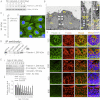Filamin A is a regulator of blood-testis barrier assembly during postnatal development in the rat testis
- PMID: 22872576
- PMCID: PMC3512009
- DOI: 10.1210/en.2012-1286
Filamin A is a regulator of blood-testis barrier assembly during postnatal development in the rat testis
Abstract
The blood-testis barrier (BTB) is an important ultrastructure in the testis. A delay in its assembly during postnatal development leads to meiotic arrest. Also, a disruption of the BTB by toxicants in adult rats leads to a failure in spermatogonial differentiation. However, the regulation of BTB assembly remains unknown. Herein, filamin A, an actin filament cross-linker that is known to maintain and regulate cytoskeleton structure and function in other epithelia, was shown to be highly expressed during the assembly of Sertoli cell BTB in vitro and postnatal development of BTB in vivo, perhaps being used to maintain the actin filament network at the BTB. A knockdown of filamin A by RNA interference was found to partially perturb the Sertoli cell tight junction (TJ) permeability barrier both in vitro and in vivo. Interestingly, this down-regulating effect on the TJ barrier function after the knockdown of filamin A was associated with a mis-localization of both TJ and basal ectoplasmic specialization proteins. Filamin A knockdown also induced a disorganization of the actin filament network in Sertoli cells in vitro and in vivo. Collectively, these findings illustrate that filamin A regulates BTB assembly by recruiting these proteins to the microenvironment in the seminiferous epithelium to serve as the building blocks. In short, filamin A participates in BTB assembly by regulating protein recruitment during postnatal development in the rat testis.
Figures






Similar articles
-
Fascin 1 is an actin filament-bundling protein that regulates ectoplasmic specialization dynamics in the rat testis.Am J Physiol Endocrinol Metab. 2014 Nov 1;307(9):E738-53. doi: 10.1152/ajpendo.00113.2014. Epub 2014 Aug 26. Am J Physiol Endocrinol Metab. 2014. PMID: 25159326 Free PMC article.
-
rpS6 Regulates blood-testis barrier dynamics by affecting F-actin organization and protein recruitment.Endocrinology. 2012 Oct;153(10):5036-48. doi: 10.1210/en.2012-1665. Epub 2012 Sep 4. Endocrinology. 2012. PMID: 22948214 Free PMC article.
-
Actin-bundling protein plastin 3 is a regulator of ectoplasmic specialization dynamics during spermatogenesis in the rat testis.FASEB J. 2015 Sep;29(9):3788-805. doi: 10.1096/fj.14-267997. Epub 2015 Jun 5. FASEB J. 2015. PMID: 26048141 Free PMC article.
-
Regulation of Blood-Testis Barrier (BTB) Dynamics, Role of Actin-, and Microtubule-Based Cytoskeletons.Methods Mol Biol. 2018;1748:229-243. doi: 10.1007/978-1-4939-7698-0_16. Methods Mol Biol. 2018. PMID: 29453575 Free PMC article. Review.
-
Actin binding proteins in blood-testis barrier function.Curr Opin Endocrinol Diabetes Obes. 2015 Jun;22(3):238-47. doi: 10.1097/MED.0000000000000155. Curr Opin Endocrinol Diabetes Obes. 2015. PMID: 25887390 Free PMC article. Review.
Cited by
-
Muscarinic acetylcholine receptor M5 is involved in spermatogenesis through the modification of cell-cell junctions.Reproduction. 2021 May 27;162(1):47-59. doi: 10.1530/REP-21-0079. Reproduction. 2021. PMID: 33970124 Free PMC article.
-
Environmentally relevant DEHP exposure during gestational and lactational period inhibits filamin a testicular expression.J Mol Histol. 2023 Oct;54(5):509-520. doi: 10.1007/s10735-023-10144-7. Epub 2023 Aug 12. J Mol Histol. 2023. PMID: 37572267
-
Diverse functions of myosin VI in spermiogenesis.Histochem Cell Biol. 2021 Mar;155(3):323-340. doi: 10.1007/s00418-020-01954-x. Epub 2021 Jan 2. Histochem Cell Biol. 2021. PMID: 33386429 Free PMC article. Review.
-
Filamin A: A regulator of blood-testis barrier assembly during post-natal development.Spermatogenesis. 2012 Apr 1;2(2):73-78. doi: 10.4161/spmg.20223. Spermatogenesis. 2012. PMID: 22670216 Free PMC article.
-
Rai14 (retinoic acid induced protein 14) is involved in regulating f-actin dynamics at the ectoplasmic specialization in the rat testis*.PLoS One. 2013;8(4):e60656. doi: 10.1371/journal.pone.0060656. Epub 2013 Apr 2. PLoS One. 2013. PMID: 23565266 Free PMC article.
References
-
- Clermont Y, Perry B. 1957. Quantitative study of the cell population of the seminiferous tubules in immature rats. J Anat 100:241–267 - PubMed
-
- Bergmann M, Dierichs R. 1983. Postnatal formation of the blood-testis barrier in the rat with special reference to the initiation of meiosis. Anat Embryol 168:269–275 - PubMed
-
- Vitale R, Fawcett DW, Dym M. 1973. The normal development of the blood-testis barrier and the effects of clomiphene and estrogen treatment. Anat Rec 176:331–344 - PubMed
-
- Toyama Y, Ohkawa M, Oku R, Maekawa M, Yuasa S. 2001. Neonatally administered diethylstilbestrol retards the development of the blood-testis barrier in the rat. J Androl 22:413–423 - PubMed
Publication types
MeSH terms
Substances
Grants and funding
LinkOut - more resources
Full Text Sources
Molecular Biology Databases

